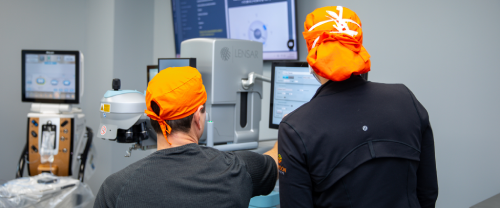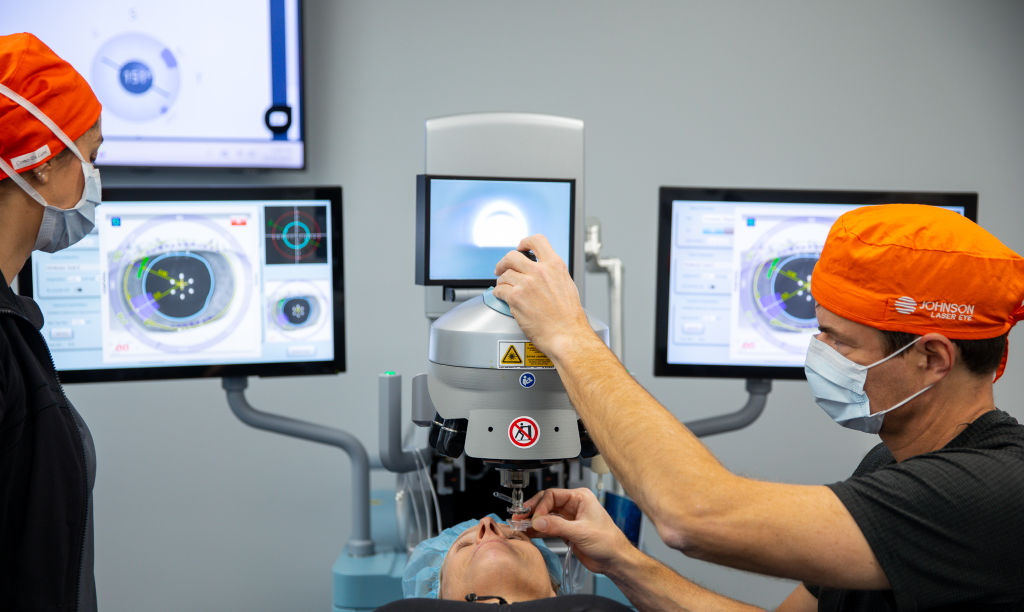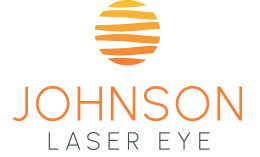
it’s a new day. see it clearly.

Johnson Laser eye
Robotic-Assisted Laser Surgery In Wilmington

Have you been diagnosed with cataracts? Are you tired of struggling with blurry or cloudy vision? Our state-of-the-art robotic-assisted laser surgery at Johnson Laser Eye is a great solution. By using advanced technology, you can achieve the crystal-clear vision you desire.
What is Robotic-Assisted Laser Surgery?
Robotic-assisted laser surgery (also called laser-assisted cataract surgery or laser cataract surgery) is a minimally-invasive procedure that breaks up and removes cataracts from the eye.
Using a femtosecond laser (the same laser used for LASIK) and robotic technology, Dr. Johnson can break up the cataract into tiny pieces. Your natural lens is then replaced with an intraocular lens. At Johnson Laser Eye, we offer a number of different lenses, including monofocal lenses, multifocal lenses, toric lenses, and extended depth of focus lenses.
The robotic surgery reduces the surgical treatment time, integrating multiple steps into one process and ensuring you can get back to your life much more quickly than with traditional surgery and manual techniques. The procedure is also much smoother and comes with fewer complications, allowing you to be comfortable throughout the treatment.
It also provides your surgeon with a level of accuracy that is often not possible without this process and with surgical instruments alone.

Candidates for Robotic-Assisted Laser Surgery
If you are experiencing symptoms of cataracts and are looking for an innovative treatment that’s not traditional cataract surgery, you are likely a good candidate for robotic-assisted laser surgery. Some of the symptoms include a cloudy lens, blurry vision, poor night vision, seeing halos or glares around lights, and increased nearsightedness.
We also recommend that you be in good overall health, be a nonsmoker (as smoking can affect the healing process), and don’t have any other medical conditions that could affect the surgery or recovery process.
What to Expect During Robotic-Assisted Laser Cataract Surgery
To start your robotic-assisted laser cataract removal surgery, we’ll begin by numbing the eye to ensure you’re comfortable throughout the procedure. From there, using advanced robotic technology and the femtosecond laser, Dr. Johnson will create a precise opening in the lens capsule and gently break up the cataract. One of the key advantages of this laser technology is its ability to correct astigmatism during the procedure by making finely calibrated corneal incisions and ensuring accurate placement of toric lens implants when needed. Because the robotic guidance allows for enhanced accuracy and precision, Dr. Johnson can directly target and remove the cataract efficiently. A new artificial lens implant (intraocular lens or IOL) will then be inserted, customized specifically to your visual needs. The entire procedure typically takes only about 10 minutes per eye. Once the procedure is done, you will be able to start the recovery process.

Robotic-Assisted Laser Surgery Recovery
As you begin your cataract surgery recovery, it’s completely normal to experience a little itching, mild discomfort, or sensitivity to light, these are all signs that your eye is healing and should improve quickly. Most patients notice a significant improvement in their vision within just 24 to 48 hours.
You’ll receive detailed aftercare instructions and prescription eye drops to support the healing process. It’s very important to follow Dr. Johnson’s guidance closely to ensure a smooth and successful recovery.
We recommend taking it easy on the day of your procedure, but most patients are able to return to light activities or even work within a day or two. We’ll also schedule a few follow-up visits to check your progress and make sure everything is healing as expected.
Your need for glasses or contacts afterward will depend on the type of lens implant you chose, and we’ll help guide you through that decision, so you know what to expect.
Schedule a Consultation
Are cataracts making it harder to enjoy everyday life? You deserve to see clearly again, and robotic-assisted laser surgery could be the safe & effective solution you’ve been looking for. We’re here to answer all your questions and help you explore your options. If you’re ready to take the next step toward clearer vision, we’d love to talk with you. Give us a call at our only location located right here in Wilmington, NC or reach out to us through our online contact form to schedule your consultation.

ROBOTIC-ASSISTED LASER SURGERY FAQ
What exactly is robotic-assisted laser surgery, and how does it differ from traditional cataract surgery?
Robotic-assisted laser surgery, also called laser-assisted cataract surgery, uses a femtosecond laser and robotic technology to break up and remove cataracts with greater precision and less manual handling than traditional cataract surgery. This minimally invasive procedure streamlines multiple surgical steps for a smoother, quicker, and more comfortable experience.
What kind of laser technology is used during the procedure?
The procedure uses a femtosecond laser, the same type of laser used in LASIK surgery, to create precise incisions and break up the cataract before removal.
How does the robotic assistance enhance accuracy or safety?
Robotic guidance allows for highly accurate placement of corneal incisions and lens implants, enabling the surgeon to target and remove cataracts more precisely and efficiently, which can lead to fewer complications and better outcomes.
Am I a good candidate for robotic-assisted laser surgery?
You may be a good candidate if you have cataract symptoms, like cloudy or blurry vision, and are generally healthy, a nonsmoker, and free of other medical conditions that could affect surgery or recovery.
How should I prepare in the days leading up to my procedure?
Patients are advised to be in good overall health and follow any specific instructions from Dr. Johnson or their provider, such as avoiding smoking and disclosing all medical conditions to help ensure a smooth procedure and recovery.
What types of intraocular lenses (IOLs) do you offer, and how do I choose the one that’s best for me?
Available IOL options include monofocal, multifocal, toric, and extended depth of focus lenses. Dr. Johnson or your provider will recommend the best type based on your unique vision needs and lifestyle preferences
Can you explain the differences between monofocal, multifocal, toric, and extended depth of focus lenses?
Monofocal lenses correct vision at a single distance, typically for far vision, while multifocal lenses offer multiple focus points for both near and distance vision. Toric lenses address astigmatism along with distance or near vision, and extended depth of focus lenses provide a continuous range of vision, often reducing the need for glasses.
How soon will I notice an improvement in my vision?
Most people notice a significant improvement in their vision within 24 to 48 hours after surgery, though full healing may take a bit longer.
What follow-up appointments will be necessary?
A few follow-up visits are usually scheduled after surgery to monitor your healing progress and make sure everything is recovering as expected.


